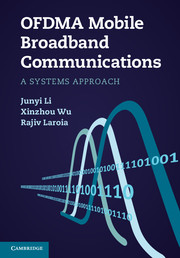Book contents
- Frontmatter
- Dedication
- Contents
- Foreword
- Preface
- List of Notation
- List of Abbreviations
- 1 Introduction
- 2 Elements of OFDMA
- 3 System design principles
- 4 Mitigation and exploitation of multipath fading
- 5 Intra-cell user multiplexing
- 6 Inter-cell interference management
- 7 Use of multiple antennas
- 8 Scheduling
- 9 Handoff in IP-based network architecture
- 10 Beyond conventional cellular frameworks
- A Overview of system operations
- B OFDM point-to-point communications
- C Brief review of channel capacity
- References
- Index
3 - System design principles
Published online by Cambridge University Press: 05 July 2013
- Frontmatter
- Dedication
- Contents
- Foreword
- Preface
- List of Notation
- List of Abbreviations
- 1 Introduction
- 2 Elements of OFDMA
- 3 System design principles
- 4 Mitigation and exploitation of multipath fading
- 5 Intra-cell user multiplexing
- 6 Inter-cell interference management
- 7 Use of multiple antennas
- 8 Scheduling
- 9 Handoff in IP-based network architecture
- 10 Beyond conventional cellular frameworks
- A Overview of system operations
- B OFDM point-to-point communications
- C Brief review of channel capacity
- References
- Index
Summary
This chapter first summarizes the system level benefits of using OFDMA as the underlying multiple access technology, and then qualitatively presents the basic system design principles of OFDMA mobile broadband communications in a cellular network. This chapter serves as a preview of many topics to be covered in the remaining chapters of the book. We emphasize the concepts and insights here and leave the quantitative modeling and analysis to the subsequent chapters.
In order to better understand the system design principles, throughout this section we often contrast OFDMA with CDMA. CDMA has been widely-used in cellular wireless communications from the second generation circuit-switched voice system to the third generation data system. A basic commonality between CDMA and OFDMA is that they are both wideband spread spectrum technologies. Therefore, comparisons between the two will help demonstrate the evolution of the system design ideas. CDMA is well studied in the literature. The readers can learn CDMA from textbooks such as [61, 159, 168].
System benefits of OFDMA
Recall that an OFDMA signal is the sum of tone signals, each being sinusoid at a given tone frequency. We next elaborate on the fundamental property of OFDMA, orthogonality, in three aspects.
When a receiver is synchronized to an OFDMA signal both in time and in frequency, the power of a tone signal is entirely contained on that tone and does not spill to others. Therefore two synchronized OFDMA signals on distinct sets of tones do not interfere with each other as long as the receiver is synchronized to them.
- Type
- Chapter
- Information
- OFDMA Mobile Broadband CommunicationsA Systems Approach, pp. 70 - 93Publisher: Cambridge University PressPrint publication year: 2013



